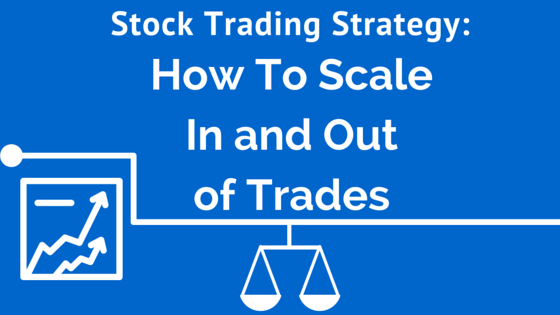Scaling in and out of trades…
…is a strategy that isn’t talked about much.
But this strategy allows you to get into the stock trading game without risking your entire account – AND you can get out of a trade without feeling like you left profit on the table.
Let’s talk about exactly what it is and how you can use it.
New trader’s face a couple of hurdles when entering trades and exiting trades. They may think that everything has to be “now or never” or that they “are all in or all out”.
This is the “go big or go home” mentality.
See if you have found yourself saying some of the these things:
- “I’m scared to place my first trade”
- “I don’t have a lot of money and I can’t afford to lose it all”
- “I got scared, so I closed my position”
- “I could have made way more if I had held on to it a little longer”
The problem with this mindset is that you are looking for absolute truths in an industry that is based on theory, probability and statistics.
Here’s a strategy you can use in all four scenarios throughout your trading career: “scaling”, also known as position sizing.
“Scaling” is the act of purchasing shares of stocks or options contracts in rounds based on a total desired state.
Scale in Using a Total Desired Dollar Amount:
For example, if you have a $8,000 trading account and you only want to invest $3,500 into XYZ stock, you may use $1,750 to purchase your first round of shares or option contracts and then wait to see if the price increases or decreases to the next level desired amount and fire off the second purchase of $1,750.
The Strategy and Why?
The strategy here, assuming you believe a stock is going to move higher, is to get in the game to see if what you believe is going to play out is in fact going to happen. If it does, then you can confidently fire off the second round of money to bring your total investment to $3,00o as discussed in the previous example.
Let’s Use Some Real Numbers
Let’s say you bought the first shares at $55 dollars. As the stock moves up, you may by the second round of shares at $57 dollars.
Although you are buying the second round of shares slightly higher, keep in mind the stock is moving in the direction that you want it to, and you will pay more for what was uncertain when you purchased the first shares at $55.
The real benefit comes in when you are wrong about a stock and it starts to go against you, because you now only have 50% of your desired investment amount moving against you, and if you still believe the stock is going up, you can use the second half of your total investment to buy shares at a lower price.
This strategy allows you to potentially be early to some trades and not wait to be precisely right trying to catch the trade at the very top or very bottom.
Scale in Using a Quantitative Number:
For example, let’s say you want to own 100 shares of XYZ stock and it’s currently trading at $28.00. You may decide to buy 25 shares at $28, and if the stock falls to $27, buy another 50 shares. And if the stock rises to $29, buy another 25 shares.
In this example, you would own your total desired state of 100 shares at an average price of $27.50.
As you can see, you purchased a mix of shares at some prices higher than when you first saw the stock, and some lower, but the average total cost allowed you to get in around the initial price you first saw the stock.
This is especially a cool strategy for longer term traders who want to accumulate a long term position in a stock they plan to hold on to, or to add stock to a position they are already holding.
The Strategy and Why?
Have you ever seen a stock that has moved higher and you felt like you missed it?
This is a strategy that allows you to buy a stock that may have broken out to the upside and potentially build a position, in case the stock never comes back down to levels seen before the breakout.
This strategy also allows you to scale into a stock that long term you feel is a good stock to own, but short term it may be experiencing a sell off.
Scale In Using the “Time Strategy”
The time strategy is one that comes in handy when you are building a long term position, or you have a big enough account with money consistently coming in to invest – like a hedge or mutual fund.
Scaling over time is the act of buying shares over calendar days, months, or even years. When you see a stock in a long term uptrend, or you just truly believe in the company, a good way to accumulate shares is over time.
For example, you may buy 100 shares of Coca Cola at $55 in January, you may buy 100 more shares again in March at $58 (assuming the stock went up) and continue to scale in over time until you reach a desired amount of shares or total investment dollar amount.
The Strategy and Why?
The strategy here, is that you have made a decision that you will put a certain amount of money to work every month, quarter, year and you have certain stocks you believe in or like the fundamentals that you find it’s the best place to park your cash and out perform what banks can give you.
This strategy does not have to always be long-term.
If you want to own 30 shares of some XYZ stock, you may buy 10 shares of a stock on Monday, another 10 on Wednesday, and another 10 on Friday to get your grand total of 30 shares.
What are the benefits of “scaling in”?
Scaling into and out of trades allows you to get in the game without worrying if “I’m getting this stock at the absolute bottom”.
You go in knowing you may buy some shares at a higher price, and you may buy some at a lower price – but what’s important is that you own the shares if that’s part of your strategy and that you get in the game and off the sidelines. You can use this same strategy with option trading as well.
We discuss strategies like this and so many more in our live, weekly, 2-hour Group Coaching sessions. To expand your trading horizons, check out this program that provides support, community, and live webinar coaching here: www.PowerTradesUniversity.com


